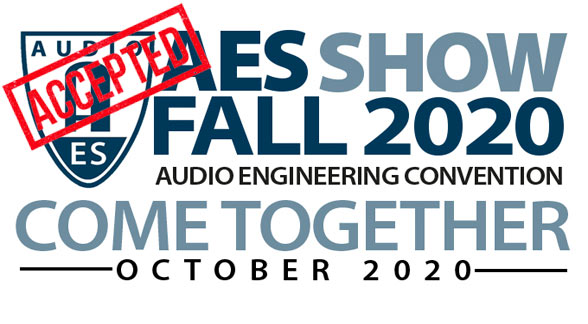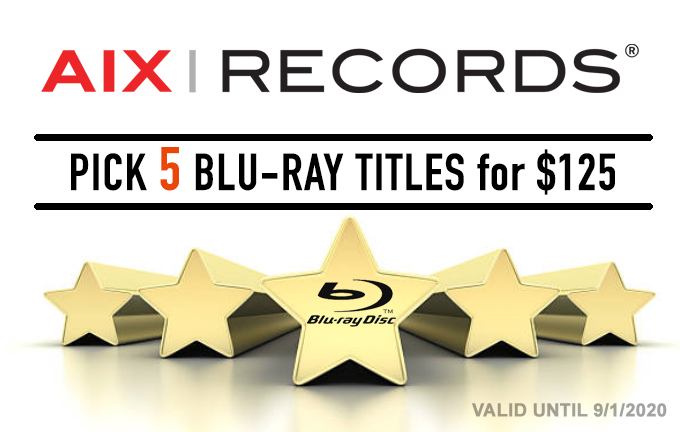The HD-Audio Challenge II Was Accepted For Fall AES!
Another low key, sunny, summer Sunday in Southern California. I’d been attempting to repair one of my two PCs and was making progress until I accidentally blew up the power supply — operator error. Don’t try to plug in a hard drive while the machine is running! I don’t know whether to abandon the effort or order a new power supply and forge ahead. There’s really no reason to fix it. I used it to author Blu-rays and do some audio processing. It’s unlikely that AIX Records will release another Blu-ray disc — or any new titles so no big loss.
HD-Audio Survey Accepted to the Fall AES Convention
I received notification from the AES Show Fall 2020 papers co-chairs this afternoon. The email stated, “It is our pleasure to inform you that your proposed paper #876413 entitled ‘Native High-Resolution versus Red Book Standard Audio: A Perceptual Discrimination Survey’ has been accepted for publication at the AES Show Fall 2020.” I’m very pleased that the co-chairs have included my sabbatical research project in the program. My hope is that my research will find a wide audience and contribute to the debate over this contentious issue.

To counter the complaint made by a fellow AES member working in the hi-res audio area about the lack of rigor in my work and the lack of strict procedures in a closed study, Archimago provided a very intelligent and appropriate response. He framed my survey as “Stage Four” in the quest for confirmation of my hypothesis. Kinda like getting a COVID-18 vaccine into the hands of the those who need it. First, you do the rigorous analysis, followed by detailed research, then small scale trials before enlisting the masses to validate the previous work. I like the analogy.
The HD-Audio Challenge II is Phase Four. It really doesn’t matter what happened in an anechoic chamber with seven 20 year old participants listening to loud noise burst at 192 kHz and 96 kHz. What matters is whether real world audiophiles listening on their own systems can perceive fidelity differences between standard-resolution and high-resolution.
So if you’re one of the late comers to the HD-Audio Challenge II and still want to participate, please request the files, download them right away, listen as soon as possible, and submit your results. At the present time, I have received 453 responses. Please go to http://www.realhd-audio.com/?p=6713 to sign up.

Cable Article Comments
I was surprised at the number of personal emails I received following my article about cables, cable reviews, cable reviewers, and the promotion of cables on audiophile websites. It seems people on both sides of the issue preferred to express themselves privately rather than post a comment at the bottom of the web page. I thought I would share a few of them — anonymously, of course.
“My last few years at RCA were in the consumer solutions department. Monster sold speaker wire that had a plastic core they claimed improved the audio quality somehow. In reality it reduced the amount of copper they used for an advertised wire gauge. It used to and still does piss me off what these crooks get away with. They consider it marketing genius and an economic win; in reality it’s criminal.”
And this one from an individual that believes cables can and should change the sound. I disagree with virtually everything he stated in his email:
“I agree with you about some really absurd prices for cables that are made from copper, silver or gold with some fancy sheaths.
I usually perform blind tests with cables – while my wife sits at the sweet spot for listening, I do the changes without touching the system – only swap the cables while my wife activates the mute button at the remote control.In most cases she can tell differences between cables, mains cables, digital cables, speaker cables, interconnects, even if the wires are reversed a change can be recognized.
There are technical reasons for differences. Many cables are flexible, so if sonics compress them, a modulation of the capacitance happens and following Coulombs laws this affects the voltage. You can connect a flexible coaxial cable to the input of an oscilloscope (while the other end is left open), use 5mV and 1ms settings, then tap on the cable and you will be amazed to see a signal on the screen. It will give a positive peak with some decaying oscillations. Microphonic effects exist with some cables.
Air has the best dielectic properties maybe followed by foamed PTFE – PVC is much worse. It is not only the purity of the wire material that can make a difference, maybe the crystal structure too.
Dielectric absorption exists. In 1992, I experimented with applying a static voltage from 3 batteries (3*9V) to a surplus inner wire and screen. This biased the insulation materials so the signal appeared small compared with that, it did not connect to the signal, because the surplus wire was insulated from the signal wires, screen was common ground. I told Bill Low (AudioQuest) about this in 1998, 5 years later he released the DBS. I made my invention, but actually, like I later found, Pierre Johannet had published such an idea 4 years before I experimented with dieletrics and the perpendicular (90°) application of voltage.
There are many other aspects to tell how cables can be made from identical pieces of wire to create different sonic results. If a speaker cable like the Kimber braid with black (right turns) and color (left turns) connects red amp output to red speaker input and black to black , one has the choice between black wires for the black terminals (as usual) or swapping black vs color on either channel in identical way. The same current in the paths but a sonic difference can be heard.
There are many experiments that end with results apart from expectation. Simplified schoolbook wisdom is unsufficient to explain the observations.
If you are self confident enough to ignore what I wrote above, I confirm my innocence. I write because I am interested in finding explanations for such phenomena. Observations can make people curious.
Most cables show directional effects, when reversed, use in opposite direction gives a minor change, still detectable by ear. I have made my own cables for all purposes an they work very well at a fraction of the usual costs. I use wires of double length an fold it in the middle so 2 legs of opposite directionality from production go in parallel. When the wires are braided or put together to create some homogenity over length, still a directional effect can be told from blind listening, In all cases the better results represent the working from source to receiver.”
This email added an interesting slant:
“As an aside I thought I would and some color commentary to your cable discussion. I actually worked as an engineer on the International Space Station for 10 years as a core network systems engineer. I personally knew the guys designing all of the cables on the space station for NASA. When talking to them about electrical quality through a cable I always got the same answer, copper is copper. Bottom line is even NASA doesn’t care about the copper in the cable being anything special. In fact the bigger concern was always the teflon coating to allow easy installation and off gassing in case of fire but never a concern beyond resistance per 1000 feet (the typical spec used to judge signal quality). Anyway, letting you know I appreciate your stance on these things and thought I’d add some unique insight.”
Some shenanigans during demos?
“Two of the most dishonest demos I have ever witnessed, year after year, were XX and XXXXXXX. Caught them both red handed acting like they hit pause and actually changed tracks or adjusted volume. XXXXXXX even went as far as using ringers in the listening group. Disgusting. I believe in good build quality as far as lasting a long time and looking cool to dress the gear but that can be had for dirt cheap. My dad was an Electrical Engineer for his entire career and taught me a thing or two about electricity.” Mike
“Thanks for your honest assessment of cable voodoo and I hope more people getting alert to this kind of false claim on cables.Thanks for your advice of ethernet cable as I use a normal cat 5 cable that does the job and costs a few dollars.”
Another:
“So it completely depends on the DAC model. Yes, audiophile DACs should buffer the data and regenerate the clock. Many don’t so that’s when different cable designs matter. Those DACs cannot be used in a professional studio though IF you are mixing real time etc.
I am in total agreement with you about tuning. But – some cables smear the sound. They screw up the treble and/or add noise. So those are to be avoided. But you can get great cabling for a system (interconnects, speaker, power and usb) all together for under $1000.00 in my opinion.
Mogami I use for my live recording btw, and Signal cable makes a great interconnect incorporating Belden. Canare I haven’t heard I will check them out. But you are correct trying to tilt the frequency response curve using cables is nuts. You want minimum interference from the cables. If your system has a frequency balance problem, use room treatment, acoustic absorbers, equipment suspension/isolation, or buy better speakers.”
A Bundle of Blu-ray Discs – Get 5 for $125
I’m pleased to announce a special offer for those of you that enjoy listening and watching audiophile music recordings and HD-Video. For a limited time, you can purchase 5 AIX Records Blu-ray discs for $125! These Blu-rays retail for $34.98. That’s a 30% discount AND shipping in the United States is on me. The coupon mechanism on the website cannot handle this sort of special, so if you’re interested in this special, contact me directly at mwaldrep@aixrecords.com to receive instructions. Thanks.

In addition, the first 25 customers can request the high-resolution downloadable files for no additional charge. Get the discs and the files for only $125. Thanks.


A few years back Charlie Randall of McIntosh was asked in an interview if the company used any special copper in their audio gear, he said no, just plain copper, it doesn’t make any difference.
Congratulations on having the contest accepted to AES.
I’ve written to regarding cables in the past regarding physics and electronics of cables at audio frequencies and Mark was kind enough to supply my complete comments in one of his post.
So again, the physics of electrical propagation in standard conductive materials(copper) is perfectly well and completely understood to many many orders of magnitude in higher frequency than the audio band [If this statement were not true would not have, among other things, communications and the internet]. There are secondary, tertiary, and so on effects which may or may not have an impact in a particular situation. But certainly there are no new physics being invented by a few folks who simply taking advantage of the lesser aware.
I thought to reiterate on a few points in response to the second post. First point is that regular conductors made from what are considered conductive materials — copper, gold, silver, steel, germanium, graphite, so on — do not exhibit directionality in conduction. Electrons propagate current only in response to difference in potential(voltage) in exactly a direction as function of that potential only. There is absolutely nothing more to that. So it is physically not possible reversing a given conductor will affect conductivity of that conductor in any way.
Second dielectric absorption(known as loss) has any kind of meaningful impact at much much higher frequencies than sonic or ultrasonic bands. And more importantly there is no such thing dielectric absorption at DC. (dielectric materials have conductive leakage at DC which is typically on order of tens or hundreds of megaohms, an error that is completely undetectable in context of much low resistance/impedance environments in audio applications). That certainly means there is no way any such test can be conducted with a static voltage generated by a DC source like the 9V battery.
Lastly while it’s possible to alter capacitance a lot of force to modulate capacitance of a typical standard solid coaxial cable enough to be sufficiently audible. The numbers of it simply don’t add up given the frequencies involved and capacitances of the cable. Capacitance of the cable is affected by it’s physical geometry and material properties. Once a cable is built these properties do not change. Any localized variation in capacitance is small compared to the overall capacitance. One would need to systematically compress and expand, and possible even permanently deform, long length of such cable to substantially vary its overall capacitance. Even if seen it’s likely a piezo effect which doesn’t imply one needs to shelf out $10K for a cable made from exotic materials.
Thanks Lenny. I appreciate your added information.
“It’s unlikely that AIX Records will release another Blu-ray disc — or any new titles so no big loss.”
Say it ain’t so, Joe?
Sorry Mark, maybe I missed reading a couple of you blogs but hadn’t heard anything like this before that I remember. It’s extremely sad that we should lose a member of the multich recording industry like this, it’s grown too small already.
Would you mind sharing the circumstances and if there is anything we can do to help?
Sal1950
I gave up my studio to paying tenants a couple of years ago. I think I proved my original goal with regards to high-resolution, multichannel, music recordings with video being better than plain old CDs. To continue is extremely expensive and I’m putting my efforts into other areas. Sorry.
Congrats Mark on the acceptance to the AES for your work!
I assume the AES convention will be all virtual this year? Hope you have fun with the presentation! I’m sure many readers will be very interested in the reception and curious if you receive much in the way of push-back from the AES community. If so, from which direction!?
As for cables… Oh man. I suppose when there’s a financial incentive, the hype will never stop until the prospect of making $$$ from these ultra-high-margin products ends. And there’s really only one way to do that which is to continue countering the nonsense and educating consumers.
As the old saying goes – “There’s a sucker born every minute.” Even if it’s impossible to stop the madness, I think it’s good to at least curb the enthusiasm with some sober reflection and critical thinking…
Keep up the good work!
PS: Typo on that COVID 19.
I am unable to see comments on this post. All of the others are fine. Ideas?